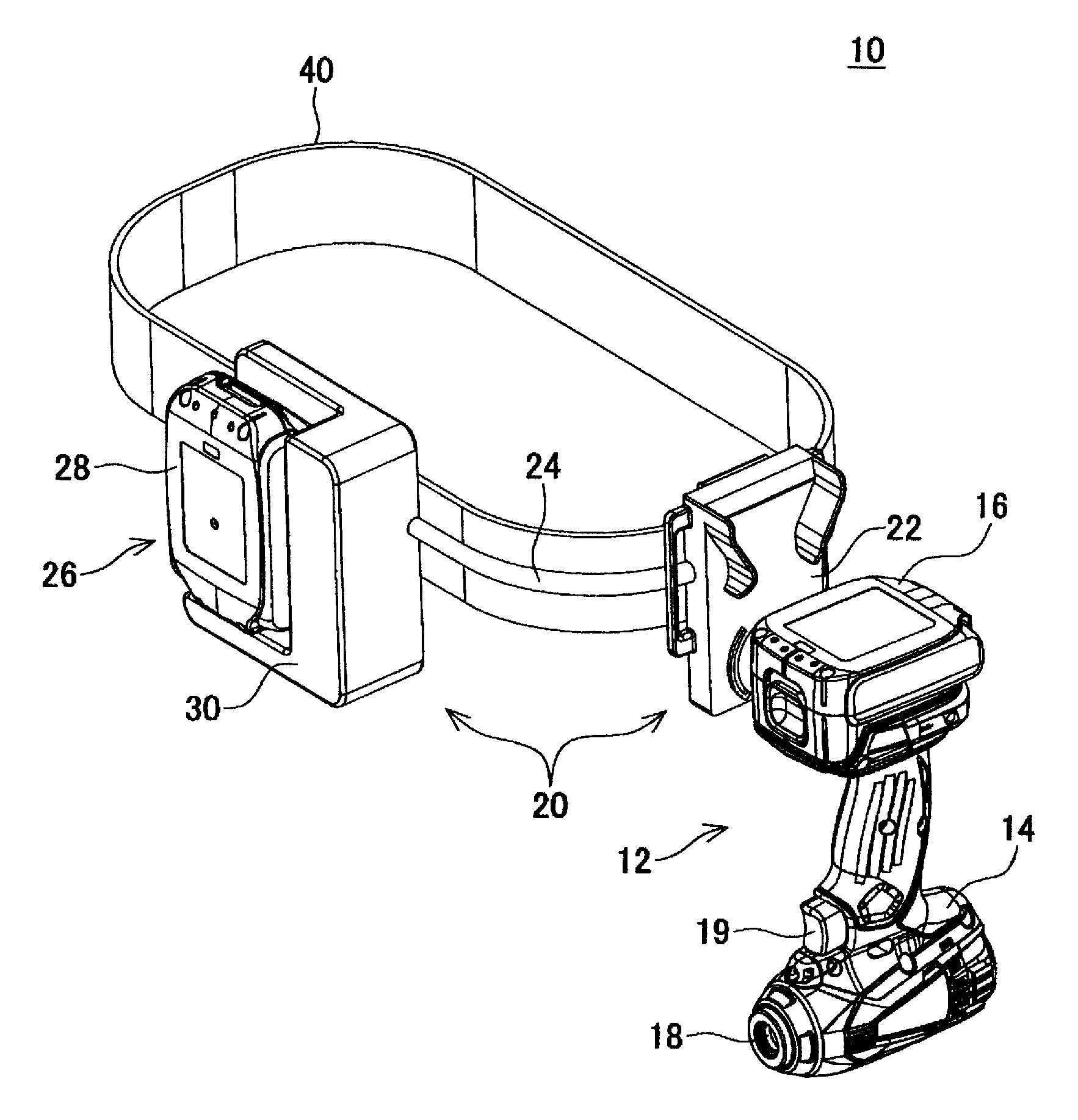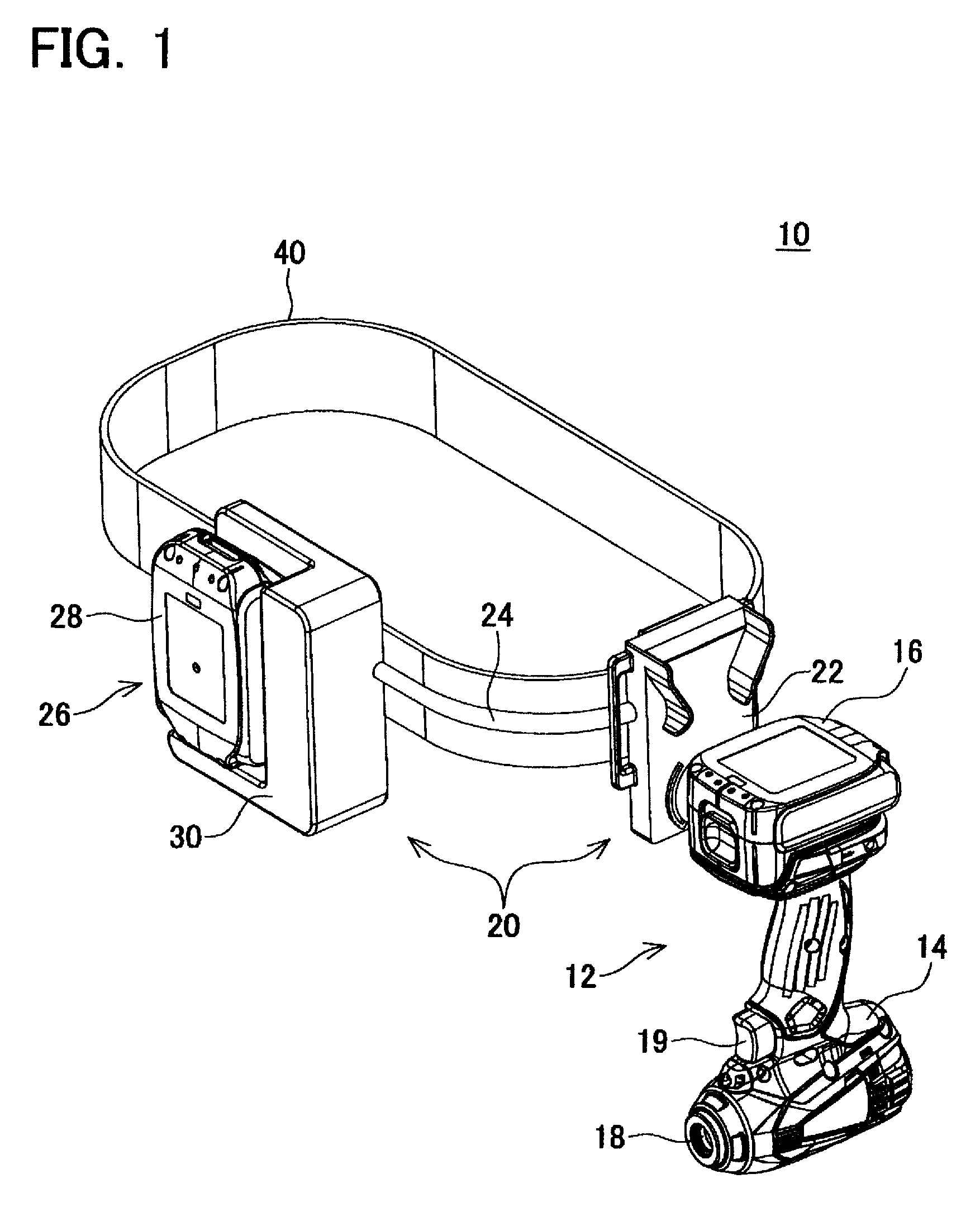Charger for hand-held power tool, power tool system and method of charging a power tool battery
a technology of power tool and charging system, which is applied in the direction of manufacturing tools, portable power tools, transportation and packaging, etc., can solve the problems of difficult or at least very inconvenient charging of the battery pack frequently during work intermissions, limited charging storage capacity of the battery pack, and limited work volume. , to achieve the effect of reducing the amount of work, and reducing the cost of battery pack charging
- Summary
- Abstract
- Description
- Claims
- Application Information
AI Technical Summary
Benefits of technology
Problems solved by technology
Method used
Image
Examples
first embodiment
[0078]A power tool system 10 of a first embodiment will now be explained with reference to the drawings. As shown in FIG. 1, the power tool system 10 comprises a hand-held power tool 12 and a charger 20. The power tool 12 comprises a tool main body 14 and a first battery pack 16. The tool main body 14 has an internal motor, which rotationally drives a tool and a tool shaft or chuck 18. The first battery pack 16 has a plurality of internal secondary batteries (e.g., lithium-ion cells) and supplies the drive current to the motor in response to the user's operation of a trigger 19. In the present embodiment, the first battery pack 16 can be attached to and detached from the tool main body 14. However, in place of the attachable / detachable first battery pack 16, one or a plurality of secondary battery cells may be directly built into the tool main body 14.
[0079]The charger 20 comprises a charger main body (base) 22 and a battery power supply 26. The charger main body 22 and the battery ...
second embodiment
[0102]A power tool system of a second embodiment will now be explained with reference to FIG. 11. The system of the present embodiment differs from the system 10 of the first embodiment only in the structure of the charger main body 22. As shown in FIG. 11, the charger main body 22 of the present embodiment is specialized for right-handed users, and the holding member 62 can rotate in only one direction. Of course, it is also possible to implement a charger main body that is specialized for left-handed users by reversing, with bilateral symmetry, the structure of the charger main body 22 of the present embodiment.
third embodiment
[0103]A power tool system 210 of a third embodiment will now be explained with reference to FIGS. 12-20. The system 210 of the present embodiment differs from the system 10 of the first embodiment in that the system 210 comprises a charger main body (base) 222 and a charging adapter 270. The power tool 12 is not modified. In addition, although not shown, a battery power supply is connected to the charger main body 222 via an electrical cord. The circuit structure of the present embodiment is also substantially the same as that of the first embodiment. In particular, it is noted that the battery power supply may utilize the same second battery pack 28 as the first embodiment described above.
[0104]As shown in FIGS. 12A and 12B, in the system 210 of the present embodiment, the power tool 12, which has the charging adapter 270 attached thereto (discussed below), also can be attached to and detached from the charger main body 222. After being attached to the charger main body 222, the po...
PUM
 Login to View More
Login to View More Abstract
Description
Claims
Application Information
 Login to View More
Login to View More - R&D
- Intellectual Property
- Life Sciences
- Materials
- Tech Scout
- Unparalleled Data Quality
- Higher Quality Content
- 60% Fewer Hallucinations
Browse by: Latest US Patents, China's latest patents, Technical Efficacy Thesaurus, Application Domain, Technology Topic, Popular Technical Reports.
© 2025 PatSnap. All rights reserved.Legal|Privacy policy|Modern Slavery Act Transparency Statement|Sitemap|About US| Contact US: help@patsnap.com



